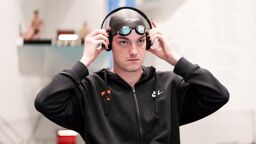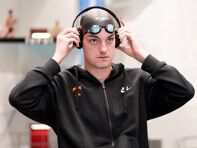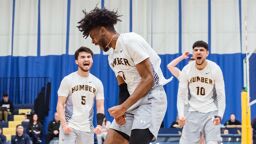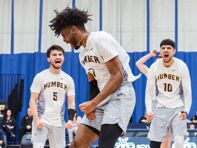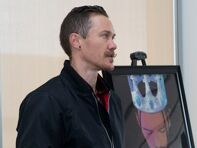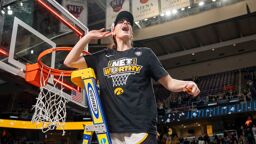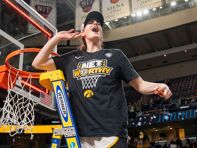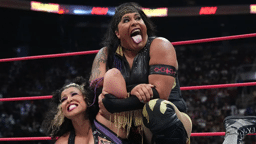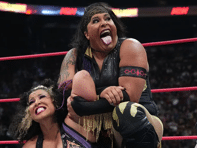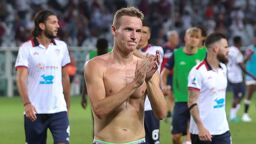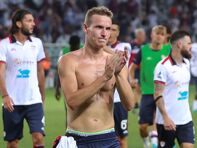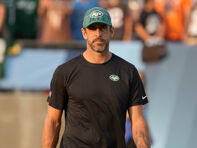Dawson LaRance owes so much to the sport of running. It’s provided him with friendship, community, and just as importantly, the opportunity to move from rural Montana to liberal Minneapolis. For the last three years, LaRance has been a mid-distance runner for the men’s track and field team at the University of Minnesota, earning All-American honors last indoor season. But as he enters his senior year, the team he loves is facing extinction.
The University of Minnesota announced last week it’s discontinuing its varsity men’s track and field team, along with two other varsity clubs: men’s gymnastics and men’s tennis. In a public letter, the school cited budgetary shortfalls due to the Covid-19 pandemic as one of the catalysts for the decision, along with Title IX requirements.
But LaRance, along with his teammates, aren’t taking the school’s explanation at face value. They are fighting to save their beloved program, beginning with an athletes’ march Wednesday.
“The coaches and our team had no idea this was about to happen,” LaRance told Outsports by phone. “They just dropped the news on us like a bomb.”
Earlier this year, Outsports covered the successful effort to save the varsity men’s track and field team at Brown University, and the integral role openly gay runners on the club played in the movement. LaRance is looking to mirror those actions, and the athletes’ march promises to be a powerful visual. Organized by the men’s and women’s track and field teams, all Minnesota athletes are invited to march from the school’s Athletes’ Village to President Juan Gabel’s office. There are also social media groups dedicated to preserving men’s track and field at Minnesota, such as the Instagram page, @reinstateumnenstf.
In recent months, track and field programs have been cut across the country, along with other non-revenue sports, such as men’s gymnastics (with the elimination of Minnesota’s team, there are now believed to be just 13 Division 1 men’s gymnastics programs left).
For LaRance, track and field has always been way more than an athletic outlet. It’s helped him live confidently as an openly gay man, beginning in middle school, when he joined his first team. In his coming out essay on Outsports, LaRance said joining track and field as a young teenager was the “best decision” of his life. He excelled at the sport, and for the first time, felt respected by his peers. No longer dogged with taunts about his voice or affectation, LaRance slowly started to open up, coming out to his parents as a freshman in high school, and later, telling some of his close friends. As a senior, LaRance connected with another young openly gay runner on Instagram, and they started to see each other — driving two hours across Montana.
Two years ago, LaRance started an advocacy group on campus for LGBTQ athletes, along with an openly bisexual teammate. He says the group, Gopher Advocates and Allies, has roughly 15 members, and last winter, helped host Pride Night for the women’s basketball team. It was the first ever specific Pride celebration for Gopher Athletics.
LaRance says his direct involvement with the athletic department makes the decision to cut men’s track and field hurt even more. He feels like his school has abandoned him. “It is frustrating for me, and my other track and field teammates, who have done a lot for our department and our sport,” he said. “They couldn’t figure out a way to support us like we’ve supported them.”

In the public letter announcing the cuts, Minnesota highlights the athletic department’s projected budgetary shortfall of $75 million, explaining how it could no longer support 25 varsity programs. The school says it anticipates an annual savings of $2.7 million once all affected athletes currently on athletics-based aid have graduated.
In addition, the school says it’s eliminating four male sports to better comply with Title IX requirements. Title IX mandates schools must offer male and female athletic opportunities that are proportionate to the representation of males and females in the undergraduate population, or show they are implementing a plan to address inequities. According to numbers the school reported to the Equity in Athletics Data Analysis, Minnesota offered 3.6 percent fewer athletic opportunities to female students in their athletic program. Undergraduate enrollment is currently 54 percent female and 46 percent male.
In an email to Outsports, assistant athletics director Paul Novak said cutting male sports was the only way the athletic department could address inequities, due to its diminished financial state. “There has been around a two percent shift in the last few years toward female undergrad enrollment, so our numbers needed to be adjusted as well,” he wrote. “Now, this could be done by adding additional female sports, but with a potential $75 million loss in revenue just this year, that is not a possibility.”
Ellen Staurowsky, a Title IX expert and professor of sports media at Ithaca College, says she’s skeptical of the school’s explanation. “From Minnesota’s statement, it seems unlikely that they are doing this for women,” she told Outsports in an email. “They say they are cutting to meet Title IX requirements, but women are basically not getting anything out of this in terms of more playing opportunities.”
In a follow-up email after publication, Novak said, “shifting campus demographics no longer allow for Title IX compliance via roster management alone, and the University now must face the risk that we would become out of compliance without action.”

LaRance says he finds the Title IX explanation dubious, given the diversity of the track and field teams. Track and field is one of the most egalitarian sports out there. It was the least expensive of 21 youth sports evaluated by the Aspen Institute, and boasts over 1 million high school participants each year.
“Track and field is so diverse, and brings so many communities together,” LaRance said. “You don’t need much, and the sports gives so many kids opportunities to participate in sport, and fill dreams. It gave me what I have today. I know there are a lot of other kids in similar positions. If track and field programs are shut down, it’s not giving those kids the same opportunities.”
As a senior, LaRance is fortunate to have already received his opportunities. His scholarship allowed him to attend a prestigious university, and experience life in a cosmopolitan urban environment. But he’s worried about those coming after him. Fewer track and field programs means fewer opportunities.
That would be disastrous for young LGBTQ athletes, as well as others who are part of marginalized communities.
“Our program just leads in diversity and inclusion with LGBTQ people and people of color,” LaRance said. “Getting rid of our program will do the university a lot of harm in terms of progress in those areas, especially given the climate today. We’re all wondering why this is happening right now, and why they chose track and field to be cut.”
Above all else, it seems like an institutional failure. LaRance says one of his coaches has explained it like this: the men’s track and field team survived so many other world calamities. It’s hard to fathom there was no way to survive this one.
“Our program has been through two world wars and a depression,” LaRance said. “Why can’t our department figure this out during a pandemic?”
This post has been updated.



